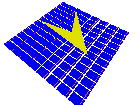
|
|
|
Dan S. Reznik
& John Canny
|
 |
Traditional "prehensile" automated manipulation involves a robot end-effector (gripper), an object, and a sequence of pick-and-place operations. Gripper and robot-arm clutter (see left inset), sensing and control difficulties, and the serial nature of pick-and-place operations, renders this approach inappropriate if several parts need to be manipulated simultaneously in a (possibly small) workspace. |
![]()
Current research in Distributed manipulation addresses this question by considering gripperless, non-prehensile devices containing a large number of simple actuators organized in array fashion. Different actuators types including micro-cilia, resonators (see right inset), rollers, air-nozzles, and electromagnetic elements are being studied. Karl Böhringer's page on Micro Actuator/Manipulation Systems contains good information on this area. |
 |
An important premise in distributed manipulation is that a large number of simple actuators can be used to manipulate a small number of parts. In combining this idea with Canny and Goldberg's minimalism in robotics, we have looked at a complementary question:
Can a device with few degrees of actuation freedom be used to manipulate -- i.e., independently translate and rotate -- a large number of parts in a planar workspace?
![]()
 |
An inspiration to this question is the bowl feeder (left inset) which achieves part orientation with a single moving actuator (the bowl!). A drawback to this device is its non-programmability, i.e., its manipulation function is tied to the shape of its internal track. We are interested in a programmable device, i.e., one for which the manipulation task can be flexibly specified in software. a note of caution: vibrations-based manipulation also has its drawbacks... :^) |
![]()
Our research in this field has started with the simpler problem of minimalist part feeding. We have studied a device made up of a single, horizontally-vibrating flat plate. The plate is constrained to translate along a single dof, e.g., X. We have shown that by introducing a simple pump-like asymmetry in the plate's vibration, parts placed on its surface feed forward at constant speed, due to the sliding frictional forces developed.
![]()
Our main result has been to show that a single horizontally-vibrating plate is sufficient for such a manipulation problem.
| © 2000 Dan S. Reznik, <dreznik@cs.berkeley.edu> |